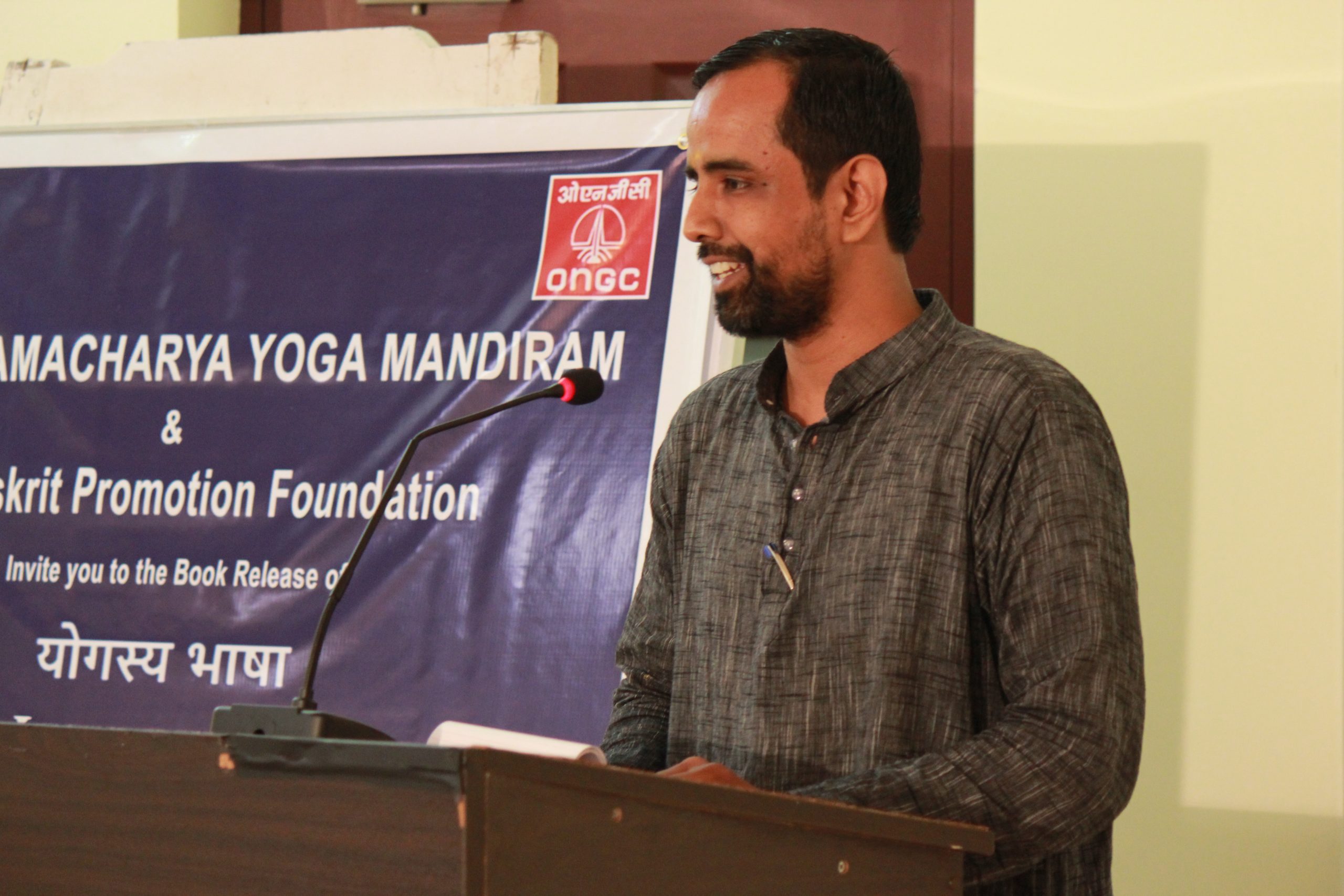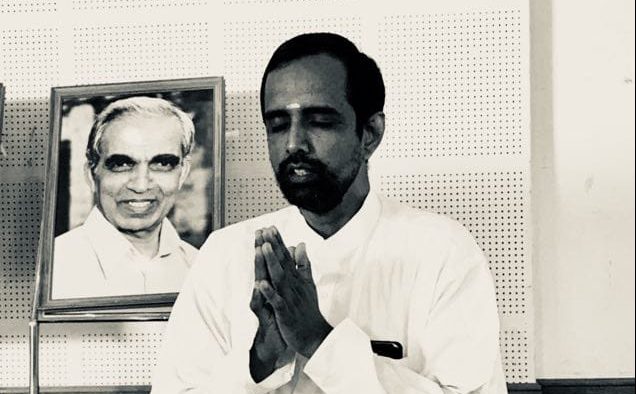Dr M Jayaraman, Director of Literary Research Department at Krishnamacharya Yoga Mandiram and a senior yoga teacher is an expert in the diverse philosophy of Yoga and in healing chants. He has worked on unpublished manuscripts on yoga which were published by KYM.
He had his traditional Vedic, Shastra education (1998-2005) in Veda Vijnana Gurukula, Bengaluru, under Acharya Ramachandra Bhat Kotemane. After that, securing UGC Research fellowship he pursued his PhD from University of Madras on ‘The Doctrine of Tantrayukti – Tantrayukti’ on the ancient Indic thesis construction methodology.
During his Gurukula-vasa, he studied Yogasutras with commentary of Sadashiva Brahmendra - Yogasudhakara under Prof Gururaj Rao, a chemistry professor, Yoga Sadhaka & Naishtika Brahmachari.
“The atmosphere in the Gurukula was Vedic and Yogic and hence naturally when I completed my PhD, by the guidance of the higher force, I had the great opportunity to join Krishnamacharya Yoga Mandiram, which is like the Kashi of Yoga in this part of the country in January 2010. With the blessings of great teacher Sri TKV Desikachar, I commenced my work in the institution in the Research Department,” says Dr Jayaraman, who has also undergone the internationally acclaimed Yoga teachers Training Program of Krishnamacharya Yoga Mandiram.
How did you get interested in translation and interpretation of Yoga texts. Which is the first original text that you handled. How was it connecting to a piece of human history?
Research in Yoga can generally be classified into two parts. a) Empirical, scientific research b) Textual, philosophical research.
With my background in Samskrita, naturally my work in the Research department of Krishnamacharya Yoga Mandiram was to focus on the textual aspects of Yoga.
The first text that I worked on in KYM was Patanjali Caritam, a work of poetry by Ramabhadra Dikshita, composed in the 17th century, in about 600 Sanskrit verses.
It is one of the few available narratives on the life of Sage Patanjali. Though it is not a historical account, it consolidates and summarizes all the stories and traditional beliefs associated with the life of the Sage who wrote Yogasutras – the foundational text in the field of Yoga. I worked on an abridged prose version of the text in Sanskrit with English and Tamil translations. The Tamil and English (with Sanskrit prose abridgement) translations that were published (2011) were my first two books. The work was received with good interest by Yoga fraternity.
There are various lessons to be learnt from the legend of Sage Patanjali. For example, Sage Patanjali is portrayed as a very strict teacher. His anger reaches to such an extent whereby he burns down all the thousand students but for one. They were punished for their distraction. This story underlines the responsibility and sincerity that Yoga teachers ought to have in handing down the precious knowledge and also the focus that the students of Yoga need to have. In recent times, Yogacharya Sri Krishnamacharya whose teachings gave healing touch the humanity sans boundaries, was a disciplinarian. Imbibing the qualities from their teacher, Sri TKV Desikachar, Sri BKS Iyengar and others served as worthy torch bearers of the glorious ancient Yogic knowledge in our current era.

How do you go about the translations? Are the texts cohesive, or are there abbreviations, and references which make them difficult to study.
All the Sanskrit texts that I have worked are the products of systematic thinking arising out of deep contemplation expressed in a very structured manner. As a translator I have tried to imbibe these qualities in my work from these ancient treasures of the past.
The difficulty of Sanskrit texts that some might experience may not be due to the language or the content itself. Most often, level of difficulty in any language or text that has a many millennia survival is directly proportional to the level of willingness to undergo training to understand the structure and framework of the language.
Did you find access to original texts? How many are available and how are they preserved?
Traditional texts, like the Sanskrit commentaries to Yogasutras were being actively published in India since the late 19th century to about mid-20th century. For example, Patanjali Caritam, that I mentioned earlier, was published in the year 1898 by Nirnay Sagar Press, Mumbai. But most of these are in Sanskrit without translations. Pdfs and scanned images of most of these are available on the web.
But there are many more texts that are to be brought to the public domain from manuscript repositories. For example, at least 28 Sanskrit commentaries to Yogasutras are known to exist. But only a little more than a dozen of them have been printed, a few of them translated and fewer studied analytically. Most of these unpublished commentaries can be traced to various manuscript repositories across the country.
Similarly, there are many texts on Hathayoga which still lie in manuscript repositories, some of which have been digitized for future access and many others are facing threat of vanishing from the face of earth due to ravages of time and other degenerative factors. It has to be noted that, more than in India, work on critical edition and study of these original sources are done in greater scale in universities abroad in current era.
What is the importance of translating the Sanskrit Yoga texts into other Indian languages as you have done in Tamil?
I think you are mentioning about the Tamil translation of the Sage Vyasa’s commentary to Yogasutras in three parts, published by Krishnamacharya Yoga Mandiram, 2015.
Importance of Translating Sanskrit texts into Tamil or into any regional language is same as that of creating irrigation channels to the fields from the river or the water source. Everyone is entitled to the elixir. Some of them can go to the sources and to others the sources should go.
What are the earliest references to 'Yoga' you have found in your study of Yoga texts? What are the Vedic roots of Yoga?
As you have indicated in your question itself, the very term Yoga exists in the Vedas, especially in the earliest text Rgveda samhita. But the term itself might not be in the same sense of Samadhi or meditative methods that we connect with Yoga now. But this does not mean that the Vedic texts do not have any reference to meditative, reflective practices.
Last year, in a conference organized by Maharshi Sandeepini Vedavidya prathisthana called b?hv?caparampar?prad?panam: Illuminations on the Rgvedic traditions – held at Veda Vijnana Shodhasamsthanam, Bengaluru (2nd March, 2019) I delivered a talk on “Elements of Yoga in Rgveda Samhita”, I analyzed the expression in the Rgvedasamhita ‘Manasa’ – which means – “by the mind”. I was interested to study what rgvedic sages did with the mind. There were about 104 occurrences of the term – ‘manasa’. By study of those occurrences, I could understand that Rgvedic sages, knew very well about the distracted state of mind, swiftness of the mind, refinement of the mind and even transcending the mind. The Vedic texts to me are the true roots of Yoga.
Do you think Patanjali's work made it easy for the world to define, describe and practice Yoga, as opposed to Tantrik texts which were not very rationally crystallised. What is Patanjali's role in the spread of Yoga?
Though Patanjali is famed as father of Yoga, I would call him the mother of Yoga. Patanjali himself says, in the very first sutra – that his text is anushasanam – a work that is based on prior teachings. A mother collects food material like pulses and grains from various sources, cooks and prepares it in a delectable and palatable manner so that the child can enjoy and assimilate the food and be nourished. Similar is the motherly role of Sage Patanjali in creating the Yogasutras from the preexisting wisdom on Yoga.
Sage Patanjali in fact, was instrumental in adapting a farsighted contemporary trend (of his times) of creating a text in the sutra format, in ensuring the perpetuation of the knowledge of Yoga. Though sutra texts in other disciplines came into being, the Yogic content that he captured in the Sutra format survived and is flourishing now because of the eternal values and the universal applicability.
Except for the Sutras, there are few texts which have been translated in Europe and America. What is the historical importance of these texts in forming a bridge between the philosophy of Ancient India and the fully developed Indian Buddhism and the religious thought today in Eastern Asia?
Your question touches various points from Buddhism to Yoga to textual history to religion in the past and contemporary times. Each of them are individually very vast topics to deal with and their connections - yet another ocean to cross.
But, in the field of textual study in Yoga, my focus is specific, the study of commentary literature of Yogasutras. With this specific focus all that I can say is, the commentary literature of Yogasutras is an unwritten chapter in the history of Yoga.
If one observes the commentary literature to Yogasutra, it can be seen that there is an unbroken continuity of texts appearing in various points of time. Vyasa’s commentary appeared closer to the period of Yogasutras themselves (3rd of 4th Century CE), then 9th and 10th centuries saw the commentarial works of Vacaspati Mishra and Bhoja. In the 15th century Vijnanabhikshu’s commentary emerged, Nagoji Bhatta in 17th century wrote two commentaries, Narayanatirtha also contributed two commentaries in the 18th century, followed by Sadashiva Brahmendra’s commentary in the 19th century and in 20th century Hariharananda Aranya wrote a (sub) commentary to Yogasutras.
Hence study of these commentaries age by age have inputs to history of Yoga.
Further, in Yogasutras, especially in the fourth chapter, there is direct dialogue with Buddhism. Studying Yogasutras with commentaries of various ages may throw light on that aspect of also.
Based on the studies undertaken by you, can one trace the route that Yoga and Tantra took out of India to the rest of the world?
As stated earlier, my focus in Yoga is limited to that of the commentary literature and so not much on the global influence or travel of the text abroad. Hence I might not have any useful insight to contribute in this connection.
However, one can study the work “Journey of the Upanishads to the West by Swami Tathagatananda" published by Ramakrishna Math (2002), that beautifully traces the journey of Indian wisdom abroad especially to the west right from the Upanishads to mathematics and also Yogic knowledge.
In Hatha and Rajayoga texts, what insights does one find on the early teachings of Hathayoga?
Hathayoga texts mention that Hatha is a stepping stone for Rajayoga . Hatha refers to channelizing the prana into sushumna, that consequently makes the mind calm and turn inwards and Rajayoga is Samadhi in the form of Citta-vritti-nirodha that is facilitated by Hatha. This the connection and essence of Hathayoga and Rajayoga as I have understood from the study of the texts.
Yoga - vaisaradi: How does this help in increasing scholarship in the field of Yoga Philosophy?
Yoga is a system of practice, But it has given equal or even greater importance to the study and understanding of the texts. Sage Vyasa, in his commentary to Yogasutras, states Uttama Yoga (best yoga) is possible through three components, Agama, anumana and Abhyasa rasa (Ref : 1.48) – authentic knowledge grasped from the texts and the teacher, ability to intellectually assimilate by one’s own reflective contemplation and by the immersing in the joy of practicing the truths and wisdom thus gathered.
Yoga-vaisharadi - https://kymyogavaisharadi.org/ - has been envisioned to facilitate the above process. This is a searchable web repository that has 14 Sanskrit commentaries of Yogasutras, Hathayogapradeepika with Jyotsna commentary and the entire Bhagavadgita text. The texts in these can be transliterated into Roman script, Kannada, Bengali and Devanagari scripts. The audio of the Vyasbhashya to all Yogasutras has also been given to enhance access to the text.
This repository will be of help to scholars and students of Yoga philosophy for their study and research. Many more useful tools and texts are proposed to be added to the repository towards dissemination of authentic wisdom of Yoga.
In your opinion, do you think there is any connection whatsoever between the Yoga described in the texts and what is being practiced today around the world?
Yes. In most cases there is connection and consonance. But to err and stray away from the age old traditions is not something unexpected. That is exactly why the yogis of the yore have left behind texts. To use them as maps to trace our way back to the intended path.
In their time, were the texts being read only by scholars or was there access to and understanding by common people?
With regard to Yoga, even without reading yoga texts, one can still be a Yogi and there were many in the past. The study of Yoga texts have two fold purposes to serve – as mentioned in the previous answer – to serve as maps that guide us to the intended path and also to serve as one among the host of other tools Yoga to heal, channelize and sublimate the mind.
What is the role of Sanskrit and Mantras in Yoga?
The Pranava mantra, its repetition and the reflection of its meaning is presented in the very first chapter of Yogasutras by Sage Patanjali for realization of Self and also to calm the mind and help attain focus. Chanting of Vedic mantras and also its integration in Yogic practices like Asana, pranayama and Dhyana towards healing processes has been given great importance by Yogacharya Sri Krishnamacharya.
With regard to knowledge of Sanskrit in the context of Yoga, I would like to state that -
Sanskrit Empowers Yogis – Delivering them from dependence on secondary sources and Translations
Knowledge of Sanskrit also helps to Discern - What is interpretation and what is the source – this leads to Clarity! And thereby instils confidence in practice.
How do you teach Sanskrit to make reading of Yoga texts easier?
I attempt to teach Sanskrit in an immersive, interactive methodology with minimum intervention of other languages inspired by the methodology of Samskrita Bharati, developed and perfected for over four decades. Even a person totally unaware of the basics of language but interested, is inspired to learn. This direct approach drives away the notion that Sanskrit is difficult.
I have experimented teaching Yoga texts in an immersive manner to students from India and abroad with very positive feedback. I wrote and presented a paper “Imparting Yoga texts in Sanskrit – An experiment and its outcome” in the 17th World Sanskrit Conference held in the University of British Columbia, Vancouver, Canada, July 2018, which was well received. (The paper can be downloaded from this link - https://tinyurl.com/ybh248qs)
The legacy of Shri Desikachar was Sanskrit scholarship. What importance is given to non-Yoga Sanskrit texts in the KYM tradition?
Every Yoga text of the past and every Yoga tradition is to be greatly valued and respected. Based on Sage Patanjali’s guidance of Ekatattvabhyasa, I can say this much, our Acharyas have given a specific focus and approach in Yogic practices based on inputs from certain Yoga texts. Following their footsteps, collectively we are in that path of overcoming – suffering.
((To read and download Dr Jayaraman’s research work: https://independent.academia.





